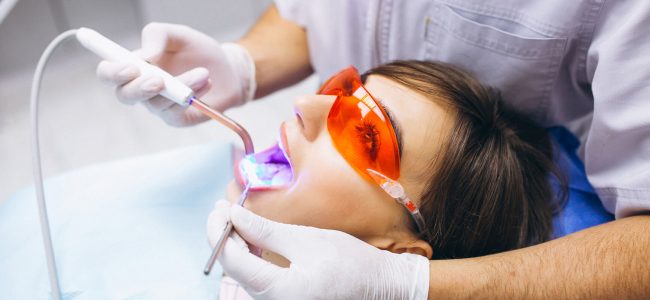Tooth decay, tooth caries, and cavities all refer to having a small hole in your tooth that requires treatment. You may experience pain or sensitivity, but most patients are unaware they have tooth decay until a dentist sees it on an X-ray. Tooth decay occurs due to a build-up of bacteria on the teeth that produces acid that creates a hole in the tooth.
Some types of early tooth decay do not always require a filling. Your dentist will recommend placing a filling in your tooth if you have advanced decay or the hole is becoming larger. The process involves cleaning out the decayed area of the tooth and replacing it with a specialized filling material.
What to Expect When You Receive a Dental Filling
When you receive a filling, first your dentist numbs your mouth with a local anesthetic. Keep in mind, if you catch the cavity when it is small enough you may avoid the need to be numbed at all! The dentist will then remove the damaged part of your tooth with a high-speed drill. The next step is to fill the hollowed-out part of the tooth with filling material. Then your dentist will place a tooth-colored filling or ‘composite’ filling to repair the damaged part of your tooth.
Composite fillings are close to the same color as your natural teeth and dentists are more likely to use them for aesthetic purposes. Your dentist takes your preference into consideration when selecting the filling material for your cavity.
After applying the composite filling material into your tooth, your dentist holds a blue light over it that prompts the material to harden as quickly as possible. Before finishing the procedure, your dentist smooths and polishes the filling to ensure that it does not feel rough and is similar in structure to its original shape. Lastly, your dentist checks your bite after placing the filling to make sure that your tooth and bottom rows of teeth still touch properly.
Your Comfort is Our Top Priority
We want you to feel comfortable and relaxed while receiving a filling and will always let you know what we are about to do. You receive anesthesia through an injection, which might pinch and sting a bit when you first receive it. However, the discomfort wears off quickly and you soon will have no sensation in your lips and gums.
You may feel some pressure as your dentist drills into your tooth to remove the decay, but the pressure is much less intense because of the medication. You may stop us at any time if you feel discomfort and we will adjust your medication or our techniques.
Once we have finished filling your cavity, a dental assistant will review how to care for your treated tooth at home. You should plan to avoid eating for a few hours after receiving anesthesia because you could bite the inside of your lips or cheeks without feeling it. Please schedule an appointment at the Ideal Dental location closest to you if you think you need a cavity filled. Delaying the procedure will only make the tooth decay grow.
Schedule an Appointment
To learn more or get started, find your local Ideal Dental office today to schedule a visit with our caring team.
